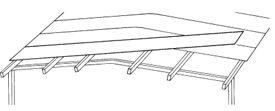Purlin Spacing
When the purlin spacing is close to the maximum allowable for the profile and ease of curvature, the roof cladding is more likely to be damaged by foot traffic and distortion between the purlins. When the radius of curvature is close to the minimum, the purlin spacing should be reduced to the end span distance for each gauge and profile. See Wind Load Span Graphs.
Access on curved roofs should be restricted and be regarded as Type B, and extra care should be taken during installation because of the changing pitch. Because some profiles used for curved roofs are close ribbed, it is not possible to walk in the pan. The walking pattern should be restricted to within 300 mm of the purlin and the load spread over two ribs. This is more important when low strength steel is used for pre-curved sheets.
Avoid using 0.4 mm G300 steel or 0.7 mm aluminium for roof cladding subjected to walking traffic.
The designer should consider the radius of curvature, profile, thickness, grade, and purlin spacing as these are all related parameters of curved roof design.
Maximum purlin spacings should be adhered to and any sheets damaged by foot traffic in the area below the minimum pitch for the profile should be replaced.
All curved roofs must have end spans reduced to two-thirds of the intermediate span, as required for straight roofs because the kl load - factor requires a reduction in purlin spacing at the roof edges. Where translucent sheets are required to be curved, the normal purlin spacings should also be reduced.
If the design loads are high, or where the eave is not lined and the roof cladding is exposed, extra fixings and load spreading washers are required.
It is important that the radii limitations and water drainage characteristics for specific products are considered at the building design stage so that water runoff over the low pitch region will not exceed the maximum for the profile used. The maximum radius of curvature permissible for corrugate and symmetrical profiles is limited for this reason.
Bull-nosed verandah or lean-to roofs, which are simply supported spans and do not have the continuity required for point load, should have their purlin spacings reduced to less than normal end spans.
Because the sheeting is continuous over the top of a curved roof and the wind dynamics are different, purlin spacings do not need to be reduced at the crest, as is normally required at the ridge on gable or hipped roofs.
The two top purlins should be placed to enable the sheeting to follow an arc that minimises purlin marking.
Because extra uplift load will be taken by the end fasteners, screws and load spreading washers should be used on the penultimate and the last purlins and screws are the preferred fastener for curved roofs, although nails may be used on intermediate purlins.
- Log in to post comments

